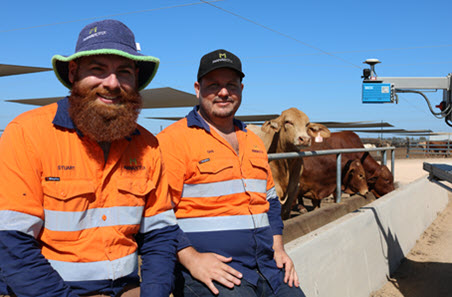Automated bunk scanner a reality

Assessing the quantity of feed remaining in cattle feed bunks is critical to optimising carcase weights and preventing digestive disorders, while also managing the efficiency of a feedlot’s feed consumption.
A new MLA project funded by grainfed levies is investigating automation of feed bunk management and has seen the development of a prototype sensor system to determine feed remaining in bunks.
Feed bunk management is traditionally undertaken by a human bunk caller, whose role directly determines feed allocation for pens of feedlot cattle for a 24-hour feeding cycle. The objectives of this process are to consistently maximise feed intake, while minimising feed wastage and digestive disorders such as bloat and acidosis.
MLA Feedlot Project Manager Dr Joe McMeniman said the project aims, for the first time in the world, to determine both the precision and accuracy of humans to estimate feed remaining in feed bunks compared to the prototype vehicle-mounted sensor system.
“Automation and robotics solutions company, Manabotix, has developed a prototype vehicle-mounted bunk scanner, which has been undergoing in-field trials at Mort & Co’s Grassdale Feedlot,” Dr McMeniman said.
“The results to date have proved very promising. MLA will publish the results of the project in late March, with the commercial technology available for feedlot adoption by mid-2018.
“The Australian feedlot industry has identified automation of manual processes as a key research and development priority. Future R&D will explore using information from the bunk scanner to develop algorithms to feed cattle.”
Manabotix Managing Director, Dr Stuart McCarthy, said the vehicle-mounted prototype’s primary sensing element is based on light detection and ranging (LIDAR) technology.
“We have onboard positioning solutions so we know very accurately where the vehicle is in a world coordinate system, and we also have an onboard attitude solution so we can account for any vehicle roll and rock and any other dynamic events to improve the quality of the signal,” Dr McCarthy said.
“The scanner has an onboard computer which takes in all of that information. It predicts how much feed is remaining and then it publishes the result at the end of measuring each bunk. It can work in day and night conditions.
“The bunk scanner is more accurate and precise than humans, and that’s from slick bunks all the way up to masses of more than a tonne of feed. The system is highly repeatable and we’re calling on average within 5% of the actual amount of feed remaining in the bunk.”
More information
Final reports:
- Prototype development for sensor technologies to automate feedlot bunk management
- Review of opportunities for Feedlot Induction Automation
Contact:
Email Dr Joe McMeniman



